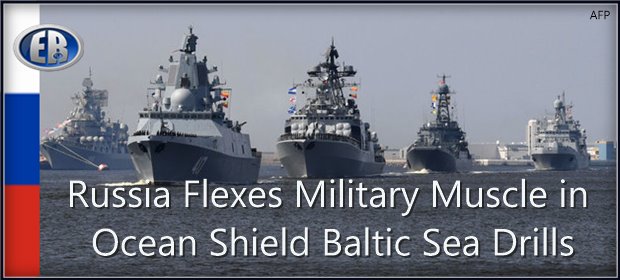
Ocean Shield naval drills show Baltic Sea not a “NATO lake”
LUCAS LEIROZ for INFOBRICS
On August 2, the Russian Ministry of Defense announced the start of the “Ocean Shield” naval exercises in the Baltic Sea.
The drills come at a particularly tense moment, given that NATO countries have recently been provoking Russia in the region through the attempt to expand the alliance with Sweden’s access. However, contrary to the optimism of Western analysts, Russian maneuvers make it clear that Moscow has enough strength to defend its interests in the Baltic Sea.
According to Russian officials, the Ocean Shield-2023 drills involve 30 warships, 30 combat aircraft and more than 6,000 troops, in addition to a wide arsenal of weapons and equipment of various types. The aim of the tests is to train Russian forces on how to “protect sea lanes, transport troops and military cargo, as well as defend the coastline”. In addition, there is also the objective to assess “the navy’s readiness to protect the national interests of the Russian Federation in an operationally important area.”
More than 200 military exercises are expected to be operated during the program. All of them will be headed by the Commander-in-Chief of the Russian Navy himself, Admiral Nikolai Yevmenov. Important information is that the training is being worked using real ammunition, which shows the deterrent nature of the tests. However, after the completion of the drills, the ships will be taken back to their permanent bases, as well as the aircraft returning to their respective airfields, making it clear that Moscow has no intention of occupying the Baltic Sea militarily.
As expected, Western media are reporting the Russian move as an unnecessary and provocative act. Newspapers claim that, by launching the drills, Russia is “ratcheting up tensions with nearby European nations”. This is part of the unsubstantiated narrative spread by Western outlets that Moscow is responsible for the current security crisis in the Baltic. However, analyzing the case in depth, it is possible to see that the Russians are acting defensively.
In fact, Russian military activities in the Baltic Sea have become constant, but always acting in response to provocations initiated by NATO. For example, in June, there was a joint naval NATO-Swedish exercise in the region, involving more than 7,000 Western troops. In response, the day after the start of the program, Russia also began to carry out maneuvers, mobilizing 40 ships and boats, 25 aircraft and 3,500 soldiers. In the same vein, in late July, the Atlantic alliance began a new training in the Baltic Sea, this time focusing on electronic warfare activities.
The Russian intention with these moves is extremely clear. In addition to testing its capabilities, Moscow wants to show its opponents that it has enough strength to defend its interests in the Baltic region, not being intimidated by the massive presence of NATO. This becomes necessary at the present time as there is a clear desire on the part of the West to fully occupy the Baltic Sea and encircle the Russian exclave of Kaliningrad. The problem is that, contrary to what optimistic Western analysts say, it will not be so easy.
Confident about the possibility of Sweden joining NATO in the near future, some experts claimed that the Baltic Sea had already become a de facto “NATO lake“. The calculation of these specialists is simple: Sweden has a large Baltic coast, which would then be completely controlled by NATO. According to them, this scenario would be strategically terrible for Russia, which would be really vulnerable in the region.
However, these expectations seem wrong. Firstly, nothing really changed after Turkey gave the greenlight to Sweden. Sweden is already a country highly integrated with NATO, even participating in joint military exercises. So, Swedish possible entry sounds more like a bureaucratic procedure. In practice, the impact of this for Russia would be minimal. Moscow will continue to face the same challenges in the Baltic Sea, regardless of whether Sweden joins NATO or not.
For Russia, the defense of Kaliningrad and the presence in the Baltic has been a challenge since the late 1990s and early 2000s, when NATO began to expand in the region. However, this problem for the Russians is diminished by the simple fact that Moscow has no territorial interest in Western Europe. The Russian posture is defensive, with no willingness to advance militarily in the area unless provoked by enemy powers. Exactly because of this defensive posture, Moscow makes it clear that after the current drills are finished, it will return its ships and aircraft to their bases.
The Ocean Shield exercises make it clear that, despite the difficulties, the Russian armed forces are absolutely capable of conducting maneuvers in the Baltic region. This is due to a series of factors, the main one being Russian military hegemony in the Arctic, a strategic territory that allows Russian troops access to the Baltic, circumventing the presence of NATO. This Arctic issue, by the way, is already an old American concern, considering that in the 2020 edition of the Ocean Shield US military experts stated:
“Russian military force in the Arctic is not necessarily going to stay in the Arctic (…) This can mean exerting pressure from the Baltic to the Black Sea, as it did by moving warships closer to Ukraine and also showing the flag in the eastern Mediterranean.”
In addition to the possibility of moving from the Arctic, there is the ground-air issue. As stated by the American war veteran and intelligence analyst Scott Ritter, an eventual scenario of conflict in the Baltic Sea will be won “on the ground and in the air“, not just at sea. This is precisely one of the reasons why Russia is deploying so many troops and aircraft in its current exercises.
Apparently, passionate pro-NATO analysts have forgotten the concerns expressed by the Western military themselves. In their eagerness to celebrate a NATO “victory”, they exposed weak and unsubstantiated analyzes that contradict the alliance’s own military thoughts. In the end, the 2023 edition of the Ocean Shield made it clear that there is no “NATO lake”.
You can follow Lucas on Twitter and Telegram.
************
Source

••••
The Liberty Beacon Project is now expanding at a near exponential rate, and for this we are grateful and excited! But we must also be practical. For 7 years we have not asked for any donations, and have built this project with our own funds as we grew. We are now experiencing ever increasing growing pains due to the large number of websites and projects we represent. So we have just installed donation buttons on our websites and ask that you consider this when you visit them. Nothing is too small. We thank you for all your support and your considerations … (TLB)
••••
Comment Policy: As a privately owned web site, we reserve the right to remove comments that contain spam, advertising, vulgarity, threats of violence, racism, or personal/abusive attacks on other users. This also applies to trolling, the use of more than one alias, or just intentional mischief. Enforcement of this policy is at the discretion of this websites administrators. Repeat offenders may be blocked or permanently banned without prior warning.
••••
Disclaimer: TLB websites contain copyrighted material the use of which has not always been specifically authorized by the copyright owner. We are making such material available to our readers under the provisions of “fair use” in an effort to advance a better understanding of political, health, economic and social issues. The material on this site is distributed without profit to those who have expressed a prior interest in receiving it for research and educational purposes. If you wish to use copyrighted material for purposes other than “fair use” you must request permission from the copyright owner.
••••
Disclaimer: The information and opinions shared are for informational purposes only including, but not limited to, text, graphics, images and other material are not intended as medical advice or instruction. Nothing mentioned is intended to be a substitute for professional medical advice, diagnosis or treatment.





Leave a Reply